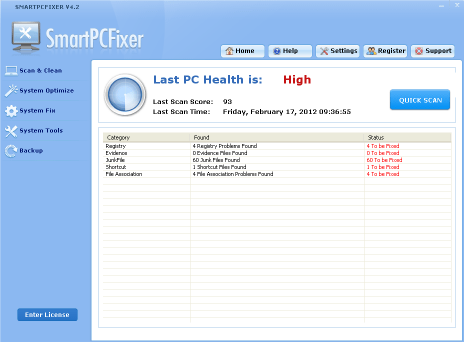Computer is run by machine language, so any error of the language will cause your PC malfunction. So getting a computer error or problem can be annoying. You don’t knnow how to get rid if them. Sometimes, you even don’t know the reason. Because one error or problem that displays the same error message may be caused by many reasons. Fixing these errors is not so much a matter of technically understanding exactly what happened, but understanding what to do to prevent it from happening again.
The firs and easiest way to clean your computer errors is to use a registry cleaner. What is a registry cleaner? Many people may have heard about registry cleaner but don’t know what it can do to your PC. Actually registry cleaner is a general referenc of the tools that can clean your computer errors efficiently. There are many kinds of registry cleaner on the market. SmartPCFixer is most used by computer owners.
To fix the problem with SmartPCFixer, please follow below steps:
- 1. Download SmartPCFixer and install it to your PC.
- 2. Do a scanning of your computer.
- 3. Fix the problem by one click.
The problem also can be fixed mannually if you know much about computer operation, but a little complicated. Note: Before following the steps below, you need to lose all of the other programs that are running and try again. Sometimes programs don’t work well together.
- 1. Start the Task Manager by hitting “Ctrl+Alt+Delete” to access the list of running programs. From here, you can close down programs running in the background that you may not need.
- 2. Restart the computer. If closing down other programs didn’t work, often a restart will resolve the problem. After you have restarted, don’t do anything else before attempting the operation again. This will reduce the possibility of other programs interfering.
- 3. Run the Scandisk program that comes with Windows. There may be some errors on your hard drive that are causing fatal errors. Sometimes Scandisk can fix the hard drive problems and prevent the error from occurring again.
- 4. Go to Windows Update and download the latest files if you are not currently up to date with all of the patches and service updates. Windows will automatically determine which updates you need.
- 5. Uninstall any recently installed software. The software may have a problem or might have installed incorrectly. It also just might not work well with other programs.
 English
English Français
Français Español
Español Deutsch
Deutsch Italiano
Italiano 日本語
日本語 Nederlands
Nederlands العربية
العربية 简体中文
简体中文 繁體中文
繁體中文 Português
Português


